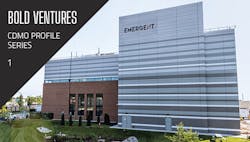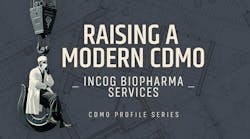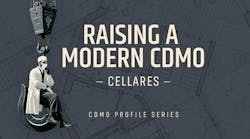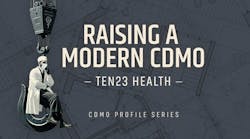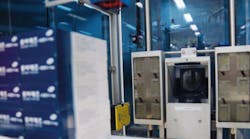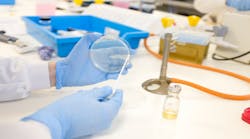Emergent BioSolutions was arguably one batch away from being a pandemic hero.
Just months after COVID-19 gripped the world, the Maryland-based life sciences company had locked in deals to manufacture two of the five leading Operation Warp Speed vaccine candidates.
Shortly after Emergent had inked what eventually became a five-year deal worth at least $480 million with Johnson & Johnson to produce bulk drug substance for Janssen’s vaccine candidate, the U.S. government issued a $628 million task order to reserve capacity for a second OWS innovator — AstraZeneca. This resulted in Emergent signing an additional $261 million deal to make drug substances for the AstraZeneca-Oxford vaccine candidate.
The tricky part? Emergent had to simultaneously ramp up production of the two novel viral vector vaccines to full scale in the same facility — its Bayview plant in Baltimore, Maryland — with a deadly pandemic spreading out of control in the background.
The situation was fraught with risk for all players involved. It was also the kind of worst-case scenario the government had in mind back in 2012 when it had earmarked Emergent’s Bayview facility as a Center for Innovation in Advanced Development and Manufacturing (CIADM).
“The scenario offered two opportunities for us to help lead the fight against the pandemic,” says Dino Muzzin, senior vice president of Manufacturing Operations for Emergent BioSolutions. “We went after it.”
This willingness to jump in head-first was on-brand for the company that has spent the last two decades supplying the U.S. government with the medical countermeasures needed to defend the country. From anthrax attacks to smallpox outbreaks, Emergent has been quietly producing protections against the most terrifying public health threats since the company’s inception in 1998.
Unfortunately for Emergent, their COVID-19 pandemic efforts were marred by what became a very public batch failure in March of 2021. This was quickly followed by an FDA site inspection that triggered a 3-month shutdown, a congressional investigation, the termination of its government-backed AstraZeneca contract and an early (mutually agreed upon) end to its involvement with the CIADM program.
Had the timing been different, Emergent’s quality issue likely wouldn’t have been national news, but given the urgency of the pandemic and the price tag attached to pandemic contracts, the country reacted — and the CDMO received the opposite of a hero’s welcome.
Today, the Bayview facility — now solely focused on the Janssen vaccine — is going through what Muzzin describes as a ‘restart phase’ that will include additional FDA inspections as Emergent works with Johnson & Johnson towards cGMP certification.
And despite having what can be generously described as a ‘rough year,’ Emergent is optimistic. More than 120 million dose equivalents of vaccines made at the facility prior to the production pause have been released by the FDA for global distribution. The Bayview plant, according to Muzzin, is in “the best position we’ve ever been” in terms of its ability to produce lifesaving vaccines.
While it’s not the path to victory anyone expected, after having time to reflect and put itself back on track, Emergent’s takeaways have not only made the company stronger, but offer valuable insight to aid future pandemic preparedness.
Readiness gaps
At the onset of the COVID-19 pandemic, Emergent’s Bayview facility was one of three designated facilities in the Biomedical Advanced Research and Development Authority’s (BARDA) CIADM network — a pandemic preparedness undertaking by the U.S. government that came to life not long after the creation of BARDA.
The CIADM partnership was inked back in 2012, granting Emergent $163 million over eight years to build capacity that could accommodate rapid domestic production. The partnership was the driving force behind a 2017 expansion project, which doubled Bayview’s size to 112,000 square feet.
“The CIADM concept was fantastic,” says Muzzin. “Coming out of the H1N1 scare, we realized the U.S. was not prepared for a flu pandemic. Big pharma and even small innovators were unlikely to invest in what is really a niche market [medical countermeasures], so the government formed this partnership.”
Fortunately for America, the need for emergency medical countermeasures has been minimal. Emergent’s CIADM had been awarded just four small task orders by BARDA since the start of the program — deals to develop Ebola and Marburgvirus therapeutics and a Zika vaccine. Then, COVID struck, officially marking the first time a CIADM was called upon to respond to a global pandemic.
“Part of the challenge was, with the contract, we didn’t get the necessary development projects as fast as we thought we were going to get them from the U.S. government. So we never kept the full staff that would be needed for commercial production,” says Muzzin.
When BARDA put the task order in place directing Emergent to reserve and subsequently release capacity to AstraZeneca, the Bayview facility was “operational at the time, but doing small-scale work,” according to Muzzin. The facility had about 100 workers on staff and needed to ramp up to at least 400 to fulfill both vaccine contracts.
“It presents challenges to find, train and scale up talent — all while you’re tech transferring or developing products in a commercial-scale GMP setting,” says Muzzin. “We knew wholeheartedly in our risk assessments that staffing up was going to be a big challenge.”
Emergent immediately broke into cross-functional workstreams, with talent management and recruitment, as well as operational readiness, leading the pack. The ‘full court press’ included internal recruitment teams as well as third party partners. Emergent got creative with incentives, including sign-on bonuses, retention packages and improved relocation offerings.
The ideal recruits were those with GMP experience, and backgrounds in areas like manufacturing systems, quality control or facility engineering — but demand for these workers was high.
“While we were scaling up, all of our competitors were also scaling up. It was a very tight market,” recalls Muzzin.
Recruitment was followed by building a robust employee orientation program which included GMP training. Concurrently, Emergent was bringing in new specialized equipment and technology required for both vaccines’ manufacturing processes.
The compressed ramp-up timeline was not ideal, but Emergent says everyone went in with their eyes open. According to Emergent, at the onset of the pandemic, Emergent, the U.S. government and Emergent’s vaccine partners recognized that, while Bayview not yet fully staffed or operating at scale, the facility was still the country’s best bet at mass-producing lifesaving vaccines for hundreds of millions of Americans.
“We were working as hard as we could, as fast as we could, understanding that we’re going to make some decisions in real time given the gravity of the task at hand. We were not going to compromise quality or patient safety — but we had to move fast,” says Muzzin.
Making the best of the worst scenario
By late fall of 2020, Emergent was manufacturing both the Janssen and AstraZeneca drug substances at full scale. The Bayview facility was operating around the clock. But just as the CDMO had established a regular manufacturing cadence in early 2021, misfortune struck.
An out-of-spec result during routine quality testing flagged a contaminated batch of drug substance early in the manufacturing process. The batch — roughly the equivalent of as many as 15 million doses of Janssen’s vaccine — was destroyed, while additional batches remained in limbo pending quality checks.
It didn’t take the media long to catch wind of what happened, but how it happened wasn’t immediately clear. Ultimately, Emergent’s investigation concluded that the contamination likely occurred when bioreactor media prepared for the Janssen product came in contact with waste materials from the AstraZeneca suite in the common weight and dispense area. It was a mistake that should have never happened — but at the same time, an issue that most biologics manufacturers have seen before.
“We immediately launched an investigation and saw what it was. We notified the FDA and stopped the batch in situ — it was never turned into bulk drug substance,” says Muzzin.
Rightfully so, this brought the FDA to Emergent’s doorstep. The agency initiated an inspection of the facility on April 12 and asked the company to halt manufacturing four days later while they rectified observations.
While a facility shutdown is every company’s worst nightmare, Emergent used the time to its full advantage.
“We said, ‘let’s take this time to really think through this — through the lens of continuous improvement — and how do we make it better?’” recalls Muzzin.
The CDMO went to work assembling a team that consisted of the best of the best — top leaders at Emergent, outside SMEs specializing in quality and contamination, and experts from Johnson & Johnson’s vast internal network. Together, they created a multiphased Quality Enhancement Plan that focused on short-term, mid-term and long-term corrections.
A lot of the immediate actions were basic fixes — but ones that Emergent hadn’t been able to do while the facility was running 24/7.
“We invested in some facility updates — everything from painting walls and epoxying the floors to putting in cleanroom wall panels in the manufacturing spaces. We also took a full look at our facility changeover and decontamination procedures just to make them even more robust,” says Muzzin.
At the forefront of the enhancements detailed in the QEP was the issue that got Emergent in hot water to begin with — potential routes of contamination. A big component of this was thorough retraining of workers in GMP process and procedure.
Program leaders from Emergent and Johnson & Johnson were meeting several times per day to review remediation activities and escalate potential problems.
“We wanted to be sure that when we started back up in August, we didn’t have any lingering issues that may have been ailing us in the past. It was a very comprehensive look across all the facets that you need to focus on in GMP manufacturing,” reflects Muzzin.
Big picture takeaways
After months in the public spotlight, you might think Emergent would be relieved to fade back into its former role of behind-the-scenes biodefense contractor. But the company already has its eyes on the next pandemic and how to make the country’s collective response better.
“It’s not if, it’s when. We don’t know what it’s going to look like — it might not be a coronavirus or an influenza virus. It might be something entirely new,” says Muzzin. “So we can’t put all of our resources and focus on one technology. We have to think about this as a multidimensional threat and look at how best do we partner with the government, other pharma innovators, other technology providers, and even with other CDMOs, to really have a variety of solutions at our disposal.”
Despite the early end to its CIADM partnership with BARDA, Emergent still believes that public-private contracts can be the path forward — but thinks policies need some fine-tuning.
“We have to think about how to construct this differently. I do know that things are afoot right now, looking at different partnerships, ways and mechanisms to make this more successful,” says Muzzin.
The recently released bipartisan Pandemic and Public Health Preparedness and Response draft bill, for example, is a hopeful step towards encouraging more timely and transparent communication between government preparedness agencies and industry partners.
In addition to stronger collaborations, Emergent stresses the importance of making manufacturing readiness a key piece of the plan. Muzzin suggests a military-like approach to manufacturing preparedness — focused, deliberate and dedicated.
“Understanding that in order to do that, it takes money, and that’s probably the biggest thing — you have to make the investment upfront so that you have people on the ready,” says Muzzin.
But no amount of money or preparedness can remove all risks from pandemic response. And those who step up to take those risks will invariably have to walk the precarious line between public hero and villain. Perhaps no company knows this better than Emergent BioSolutions.
So, all told, would Emergent do it again? When the next pandemic comes around and the government comes knocking on facility doors, will Emergent answer?
“Absolutely. This is what we do,” says Muzzin.
